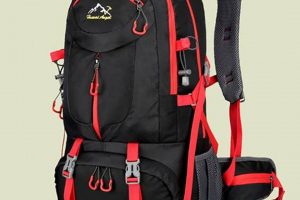The activity involves traversing natural terrain, typically on foot, while carrying essential supplies and equipment within a specialized rucksack designed to resist water penetration. For example, a multi-day trek through a rainforest necessitates a pack capable of shielding its contents from prolonged exposure to precipitation.
Such a practice offers advantages, including safeguarding valuable items from moisture damage and ensuring that necessities remain functional in adverse weather. Historically, rudimentary methods of water resistance were employed, evolving over time with advancements in materials and manufacturing techniques to provide increasingly effective protection.
The following sections will examine critical aspects of choosing appropriate gear, maintaining its water-resistant properties, and employing optimal packing strategies for extended outdoor excursions.
Essential Considerations
Optimizing the experience requires careful planning and execution. The following tips address critical aspects for successful and comfortable journeys.
Tip 1: Select a Backpack with Appropriate Waterproofing. Verify the pack’s construction materials and waterproofing rating. Durable fabrics combined with taped seams offer superior protection against water ingress.
Tip 2: Utilize a Waterproof Pack Cover for Enhanced Protection. Even with inherent resistance, a separate cover provides an additional barrier, especially during prolonged or heavy rainfall.
Tip 3: Employ Dry Bags for Sensitive Equipment. Electronics, documents, and medical supplies should be housed within individual dry bags inside the main compartment. This isolates potential damage and ensures redundancy.
Tip 4: Distribute Weight Evenly within the Pack. Proper weight distribution enhances comfort and stability, minimizing strain and potential imbalances on uneven terrain. Heavier items should be positioned closer to the center of gravity.
Tip 5: Regularly Inspect and Maintain the Pack. Check for tears, punctures, or seam degradation. Clean the pack after each use to prevent mold or mildew growth, which can compromise water resistance.
Tip 6: Practice Packing Techniques Before the Excursion. Familiarize oneself with the most efficient and organized packing method to maximize space and minimize shifting during movement.
Tip 7: Be Mindful of External Attachment Points. Ensure that items secured externally are also adequately protected from moisture or potential damage. Consider employing waterproof cases or wraps for exposed gear.
Adhering to these guidelines maximizes the protective capacity of your equipment and ensures a more secure and enjoyable experience.
The subsequent section will address common challenges encountered during expeditions and strategies for effective resolution.
1. Material Durability
Material durability constitutes a fundamental element in the context of effective outdoor pursuits. The integrity of a rucksack’s fabric directly influences its capacity to withstand the rigors of diverse environments. Inadequate material strength predisposes the pack to damage from abrasion against rocks, branches, and other natural obstacles. Such damage invariably compromises the overall water resistance, permitting moisture penetration and potentially rendering the contents unusable or damaged.
The selection of robust materials, such as high-denier nylons or specialized laminated fabrics, mitigates these risks. For example, a pack constructed from a ballistic nylon, known for its exceptional tensile strength, is far more likely to withstand the wear and tear of a multi-day trek through dense vegetation than one made from a thinner, less resilient material. Similarly, reinforced stitching and strategically placed abrasion-resistant panels further enhance the pack’s ability to endure harsh conditions. Real-world situations where a hiker’s gear is protected solely due to the pack’s material integrity exemplify the importance of this attribute.
Therefore, prioritizing material durability during pack selection is essential for maximizing the longevity and functionality of the equipment. While specialized coatings and treatments contribute to water resistance, the underlying fabric’s ability to resist physical damage remains paramount. The intersection of material strength and waterproof capabilities dictates the pack’s overall suitability for demanding outdoor activities. Neglecting this connection introduces substantial risks, potentially jeopardizing the safety and success of the excursion.
2. Seam Construction
Seam construction is a critical determinant of water resistance in load-bearing outdoor equipment. The inherent vulnerability of stitched seams to water penetration necessitates specialized techniques to maintain impermeability. Improper seam construction can negate even the most waterproof fabrics.
- Taped Seams
Taped seams involve applying a waterproof tape over the stitched seam. This tape, typically made of polyurethane or other waterproof materials, is heat-bonded to the fabric, creating a continuous barrier against water ingress. The tape effectively seals the needle holes created during the stitching process. Without taping, water can wick through these holes, saturating the pack’s interior. For example, high-end mountaineering packs invariably employ taped seams to withstand extreme weather conditions.
- Welded Seams
Welded seams represent an alternative to traditional stitching. This technique utilizes heat or radio frequency energy to fuse fabric panels together, eliminating the need for needles and thread altogether. The resulting seam is inherently waterproof due to the absence of perforations. Welded seams are commonly found in dry bags and other applications where absolute watertightness is paramount. However, welded seams can be less flexible than stitched seams and may be more prone to delamination under stress if improperly executed.
- Seam Placement
Strategic seam placement minimizes the likelihood of water exposure. Seams located on the top or sides of a pack are less susceptible to direct water contact than those on the bottom or front. Designing packs with fewer seams also reduces the overall potential for leaks. For instance, some packs utilize a single continuous panel to form the main body, thereby eliminating multiple seams and enhancing water resistance. In practical terms, seam placement has a significant role in waterproof backpack design.
- Stitch Density and Thread Type
The density of stitches per inch and the type of thread used influence seam integrity. Higher stitch density creates a tighter, more water-resistant seam, while durable, water-resistant threads, such as those made from nylon or polyester, minimize wicking and degradation. Insufficient stitch density or the use of absorbent threads can compromise the effectiveness of taped seams. Therefore, manufacturers often specify precise stitch densities and thread types to ensure optimal seam performance.
In conclusion, the success of waterproof backpack hiking is heavily influenced by the seam construction employed in the pack’s design. Taped seams, welded seams, strategic seam placement, and careful consideration of stitch density and thread type all contribute to creating a water-resistant barrier. Understanding these nuances allows for informed selection of equipment suited to specific environmental demands, safeguarding gear from water damage.
3. Waterproof Rating
Waterproof rating serves as a quantified metric indicating the level of protection a material affords against water penetration. In the context of trekking with specialized rucksacks, understanding this rating is crucial for selecting gear appropriate to expected environmental conditions.
- Hydrostatic Head Test
The hydrostatic head test, the standard method for determining a material’s waterproof rating, measures the amount of water pressure a fabric can withstand before leakage occurs. The rating is typically expressed in millimeters (mm), representing the height of a column of water that the material can support without water passing through. For example, a rating of 2000mm implies the fabric can resist the pressure exerted by a 2000mm column of water. In practical applications, fabrics with lower ratings may suffice for light rain, whereas those with higher ratings are necessary for prolonged exposure to heavy precipitation or submersion. For successful and safe “waterproof backpack hiking”, it is essential to choose a rating suitable for predicted weather conditions.
- Impact on Pack Construction
The waterproof rating significantly influences design and construction. Higher ratings necessitate denser weaves, specialized coatings, and more robust seam sealing techniques. Materials with inherently high ratings may be heavier and less breathable, leading to design compromises. Therefore, manufacturers balance waterproof performance with factors such as weight, durability, and comfort. A pack intended for alpine ascents requires a higher waterproof rating and corresponding construction than one designed for day hikes in drier climates. The design and cost of gear for “waterproof backpack hiking” are thus directly linked to the specified waterproof rating.
- Real-World Performance vs. Lab Results
While lab testing provides a standardized benchmark, real-world performance can vary. Factors such as abrasion, flexing, and prolonged exposure to sunlight can degrade waterproof coatings and reduce their effectiveness. Additionally, the pack’s overall design, including zipper placement and closure systems, influences its capacity to prevent water ingress. Even a pack with a high fabric waterproof rating can leak if its zippers are not adequately protected. Hikers should therefore consider the limitations of lab ratings and prioritize packs with design features that enhance real-world waterproof performance during “waterproof backpack hiking”.
- Maintenance and Longevity
Maintaining the waterproof integrity necessitates proper care. Regular cleaning removes dirt and debris that can compromise coatings. Periodic re-application of durable water repellent (DWR) treatments replenishes the fabric’s water-shedding properties. Storing the pack in a dry, well-ventilated area prevents mold and mildew growth, which can damage coatings and fabrics. Neglecting maintenance reduces the pack’s waterproof performance over time, regardless of its initial rating. Thus, the longevity and reliability for “waterproof backpack hiking” relies heavily on consistent and careful maintenance.
The various elements associated with waterproof rating underscore the importance of a nuanced understanding beyond simple numerical values. Informed selection necessitates a comprehensive assessment of construction, design, anticipated conditions, and maintenance practices. Combining these factors provides the highest likelihood of success.
4. Pack Cover Integration
Pack cover integration represents a critical supplementary measure in waterproof backpack hiking, augmenting the inherent water resistance of the pack itself. The primary function of a pack cover is to provide an external barrier against precipitation, deflecting water away from the pack’s surface and preventing saturation of the outer fabric. This action lessens the burden on the pack’s internal waterproofing mechanisms, extending their lifespan and effectiveness. For instance, during a prolonged downpour, a well-fitted pack cover significantly reduces the amount of water that reaches the pack’s seams and zippers, common points of water entry. In the absence of a pack cover, the pack’s fabric would eventually become saturated, potentially leading to moisture penetration and damage to the contents. Pack cover integration, whether through dedicated attachment points or elasticized edges, ensures a secure fit, preventing the cover from being dislodged by wind or snagged by vegetation. This stable configuration maximizes the cover’s protective capability, ensuring that even in adverse conditions, internal equipment remains dry.
The practical significance of pack cover integration extends beyond mere protection from rain. In snowy conditions, a pack cover prevents snow accumulation, which can melt and seep into the pack’s fabric as temperatures fluctuate. Moreover, a brightly colored pack cover enhances visibility in low-light conditions or during search and rescue operations. Consider a scenario where a hiker becomes separated from their group in dense fog. A pack cover with a reflective surface could significantly increase their chances of being spotted. Beyond weather protection, a pack cover also serves as a barrier against mud, dust, and other environmental contaminants, helping to maintain the pack’s cleanliness and prolong its lifespan. Therefore, the benefits of pack cover integration are multifaceted, encompassing both water resistance and enhanced safety in various outdoor environments. A pack cover acts as a shield for the pack itself when properly integrated.
In summary, pack cover integration is not merely an optional accessory but an integral component of a comprehensive waterproof strategy for backpack hiking. While a pack may boast a high waterproof rating, a pack cover provides an additional layer of protection that mitigates the risks associated with prolonged exposure to precipitation and other environmental elements. Selecting a pack with well-designed cover integration features ensures a secure and effective barrier, enhancing the overall waterproof performance and contributing to a safer and more enjoyable outdoor experience. The connection between pack cover and pack is key for “waterproof backpack hiking”.
5. Equipment Protection
Equipment protection constitutes a central tenet of successful excursions into environments where water exposure is probable. The correlation between effective safeguarding of carried items and the activity of traversing terrain with a water-resistant rucksack is directly causal. Inadequate protection mechanisms expose sensitive gear to moisture damage, potentially rendering it unusable and jeopardizing the entire undertaking. The reliance on technology, navigational aids, and essential supplies mandates rigorous safeguarding measures. Imagine a multi-day alpine trek; failure to adequately protect a GPS device from water renders it inoperable, severely compromising navigation and increasing the risk of disorientation or stranding. Similarly, compromised medical supplies due to water exposure negate their utility, potentially leading to adverse health outcomes.
The utilization of various equipment protection strategies acts as a preventative measure against such scenarios. Internal dry bags, constructed from impermeable materials, isolate susceptible items such as electronics, documentation, and clothing. Proper packing techniques, including distributing weight and segregating items by type, minimize the risk of internal abrasion and potential damage during movement. External attachment points, frequently employed for securing items such as trekking poles or ice axes, require specific consideration. These exposed items should be encased in waterproof covers or treated with water-repellent coatings to prevent moisture ingress and subsequent damage. Furthermore, careful consideration should be given to the selection of durable, water-resistant containers for food supplies, minimizing the risk of contamination and spoilage. The proactive measures represent an investment in risk mitigation and contributes significantly to the overall success.
In conclusion, a comprehensive strategy that encompasses durable containers, protective bags, water repellent, and packing practices is vital for equipment protection. Its successful execution ensures that crucial gear remains fully functional throughout the excursion, mitigating risk and contributing to a safer and more rewarding journey. Failing to protect the equipment can directly impact safety and success.
Frequently Asked Questions
The following questions address common inquiries concerning the selection, maintenance, and utilization of specialized equipment designed to resist water penetration during outdoor expeditions.
Question 1: What constitutes an acceptable waterproof rating for extended excursions in consistently wet environments?
A rating of 2000mm or higher is generally recommended for protracted exposure to rainfall. Lower ratings may prove inadequate in preventing moisture ingress, potentially compromising essential gear.
Question 2: How frequently should durable water repellent (DWR) treatments be reapplied to maintain waterproof performance?
The frequency of DWR reapplication depends on usage intensity and environmental factors. Visual inspection for water beading and reduced water resistance serves as a reliable indicator. Reapplication is typically necessary after thorough cleaning or every few months with frequent use.
Question 3: Are waterproof zippers inherently impervious to water penetration?
While waterproof zippers offer enhanced resistance compared to standard zippers, they are not entirely impermeable. Prolonged submersion or exposure to intense water pressure may still result in leakage. Supplementary protection, such as storm flaps or zipper garages, is recommended.
Question 4: Does seam taping guarantee complete waterproofness?
Seam taping significantly enhances water resistance but does not provide an absolute guarantee. The integrity of the taping can degrade over time due to abrasion, flexing, or improper storage. Regular inspection and maintenance are essential.
Question 5: What is the optimal method for cleaning equipment without compromising the waterproof membrane?
Hand washing with a mild, non-detergent soap is the preferred method. Harsh detergents, bleach, and machine washing can damage or delaminate waterproof coatings. Thorough rinsing and air drying are crucial to prevent residue buildup.
Question 6: Is a dedicated pack liner a suitable alternative to a waterproof rucksack?
While a pack liner offers a degree of protection, it is not a complete substitute for a purpose-built water-resistant backpack. Liners can shift, tear, or fail to adequately seal, leaving contents vulnerable. A combination of both provides the highest level of security.
These answers provide an introductory resource for understanding critical facets of choosing the appropriate gear for extended outdoor excursions.
The subsequent section will address advanced techniques for water protection in specialized environments.
Conclusion
This exploration has underscored the critical role of water resistance in equipment designed for outdoor pursuits. It has detailed key elements influencing performance, ranging from material durability and seam construction to waterproof ratings, pack cover integration, and strategies for protecting internal supplies. Attention to these factors is paramount for maintaining functionality and minimizing the risk of gear compromise in wet environments.
Ultimately, diligent preparation, informed equipment selection, and conscientious maintenance are essential for mitigating the challenges posed by adverse weather conditions. Adherence to these principles significantly enhances safety and ensures the successful completion of extended outdoor excursions. Investing in the right knowledge and gear is an investment in the experience itself.



![Best Target Hiking Backpack [Deals] & Reviews Ultimate Backpack Traveler Guide: Tips, Destinations & Budget Hacks Best Target Hiking Backpack [Deals] & Reviews | Ultimate Backpack Traveler Guide: Tips, Destinations & Budget Hacks](https://backpack-traveler.com/wp-content/uploads/2025/10/th-619-300x200.jpg)



